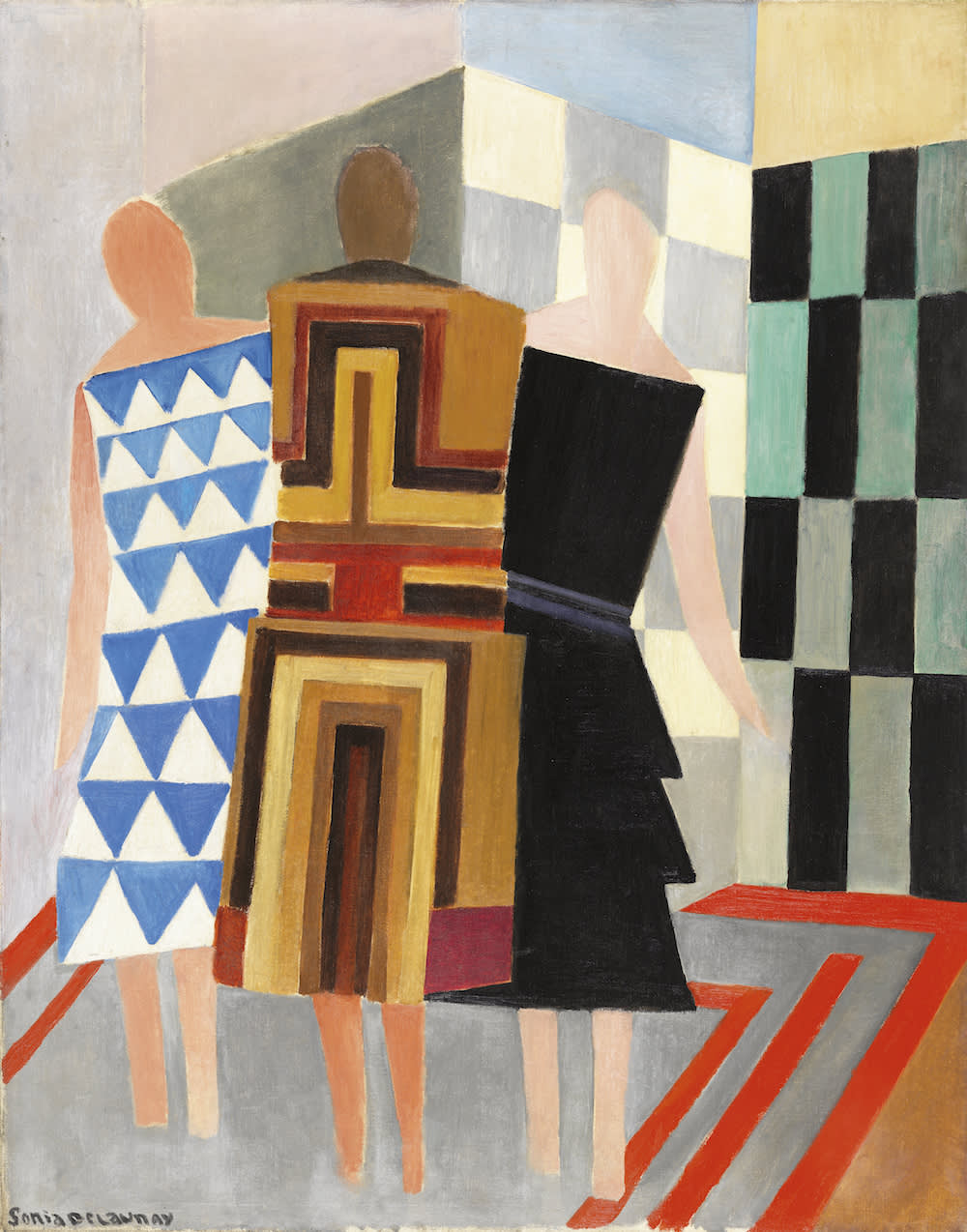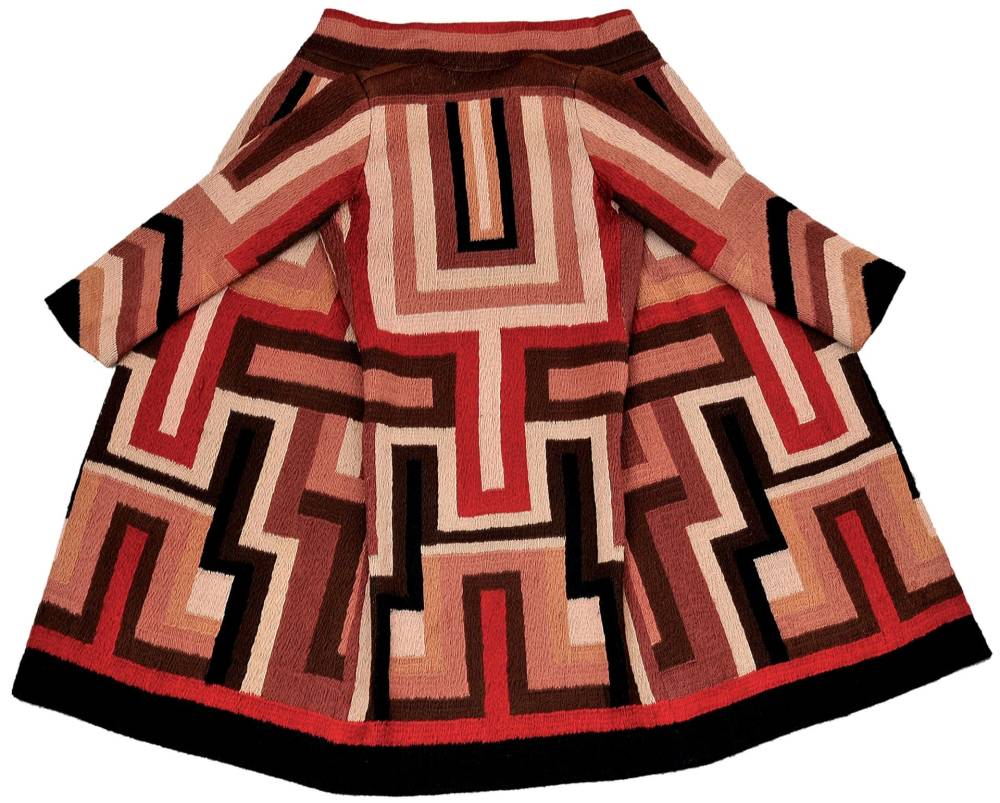
Sonia Delaunay
Three Women, 1925
Russian born artist Sonia Delaunay arrived in Europe in 1910 and spent over a decade at the heart of Paris’ avant-garde. Together with her husband Robert Delaunay, a pioneer in the field of abstract painting, the duo founded the Orphism art movement – a version of cubism – through their collective creative exploration of color and form. While Robert received numerous accolades for his artistic achievements, it was Madame Delaunay’s work as a textile and fashion designer that made her stand out as a true visionary.
Stemming from an early fascination with color, inspired by Fauvism, Sonia’s breakthrough work in textile design came shortly after meeting her husband in 1911, through a patchwork blanket the artist stitched for her newborn son, Charles, composed of a melody of pinks, creams, greens and maroon shapes contrasted by subtle hints of black. This spontaneous design constructed out of maternal desire, came to serve as an early embodiment of Sonia’s trademark artistic style, which melded Russian folk-art with elements of the Parisian avant-garde.

Sonia Delaunay
Quilt Cover Stitched for her Son, Charles, 1911
Delaunay continued experimenting with color and geometry through a technique she coined ‘simultanéisme,’ denoting the simultaneous designs that occur when placing bright hues and shapes next to one another, similar to that of color theory. As figurative elements quickly fell out of her work in a movement towards total abstraction, as did painting. Before long, her art was wearable.

Sonia Delaunay
Simultaneous Dress (La Robe Simultanée), 1913
After the outbreak of WWI, Delaunay relied heavily on her work in costume design as a means of generating income. In 1917, the artist was commissioned to create garments for the Ballet Russes' adaptation of Cleopatra, which incorporated her simultaneous visual language, as well as glossy textures and rich gold detailing. The success of these designs was instrumental in Delaunay procuring a number of notable projects in the theater and film arena.
Sonia Delaunay
Costume for the ballet Cleopatra, 1918
Lubov Tchernicheva as Cleopatra, 1918
Costume designed by Sonia Delaunay
Sonia Delaunay
Costume for the ballet Cleopatra, 1918
Sonia Delaunay
Costume for the ballet Cleopatra, 1918
By the 1920s, as Delaunay transitioned her primary mode of expression to needlework, she began making clothing for herself and her friends, applying her dynamic, spontaneous technique to their design and construction.
Sonia Delaunay
Simultaneous Dresses, 1925
Sonia Delaunay
Designs, 1920s
Sonia Delaunay
Outfits, 1920s
Sonia Delaunay
Beachwear Designs, 1928
Her garments rejoiced in movement and relished in contrasts, denoting a distinct lifestyle on part of the wearer, encapsulated by mystery and adventure. Her creations were for the modern women and focused on real-life requirements, offering driving caps for travel, bathing costumes for sports, and simple dresses as work attire, all of which included melodies of color, geometric shapes and a visual rhythm akin to the artist’s earliest paintings.
Sonia Delaunay
Dress, 1928-1929
Sonia Delaunay
Dress, 1925
Sonia Delaunay
Swimsuit, 1928
SOnia Delaunay
Beach Set, 1928
Delaunay’s trademark style quickly took over Paris. By the 1920s she established a studio called ‘Sonia,’ dedicated to creating textiles and clothing for private clients, as well as opening an atelier together with French couturier Jacques Heim. The artist’s earliest commissions were garments for the upper echelon of society, including a coat for movie star Gloria Swanson, comprised of geometric shapes rendered in rich shades of spicy red, brown and cream. What began as a radical creative experiment in testing the limits of color and form, quickly became a high fashion brand.

Sonia Delaunay
Coat made for Gloria Swanson, 1924
The artist’s newly established business and feverish focus on fabric and textile design unified an otherwise subdivided creative process. Delaunay understood the manner in which her prints would be utilized in the construction of a final garment, generating perfect visual harmony and an onslaught of female fans.
This unique creative consciousness continued throughout the 1920s when Delaunay responded to the work of the Parisian avant-garde and began incorporating surrealist text on her garments in a collection of embroidered poem dresses.
Sonia Delaunay and Tristan Tzara
Poem Dress, Oublions les oiseaux…, 1922
Sonia Delaunay
Poem Dress no.1329, 1923
Sonia Delaunay
Poem Dress no. 1328, 1920s
By the 1930s, Delaunay’s textiles evolved from including mostly geometric lines and shapes to relying heavily on wheels, arcs and flowers. At which time, she became aware of the possibilities enabled by mass, mechanical production and once again took reactionary measures, understanding that fashion was becoming an increasingly democratic system.
Delaunay’s radical move from painting to designing fabrics and garments was an early exercise in the celebration of female liberation. Today, many of her designs are national treasures, living mostly in institutions, while her unique textiles and masterful ability to manipulate shapes and colors still permeate the world through the collections of countless contemporary designers.


